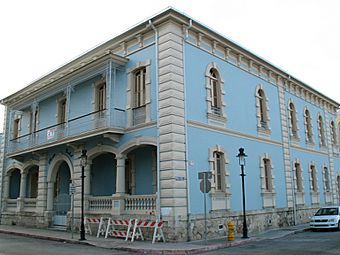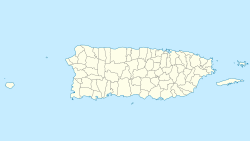Rosaly–Batiz House facts for kids
Quick facts for kids |
|
|
Rosaly–Batiz House
|
|

The Rosaly–Batiz House in Barrio Primero
|
|
| Location | 125 Villa St./ Corner of Mendez Vigo St., Ponce, Puerto Rico |
|---|---|
| Area | 0.3 acres (0.12 ha) |
| Built | 1897 |
| Architect | Manuel V. Domenech |
| NRHP reference No. | 86002768 |
| Added to NRHP | September 29, 1986 |
The Rosaly–Batiz House (in Spanish, Residencia Rosaly-Batiz) is a very old and important building. It is located on Villa Street in the Primero neighborhood of Ponce, Puerto Rico. This house is part of the city's historic district. It was built in 1897.
The house was designed by Manuel V. Domenech. He was a famous architect from Puerto Rico. He designed many other buildings that are now considered historic. Mr. Domenech built this house for Pedro Juan Rosaly, who was the mayor of Ponce at the time. Manuel Domenech himself later became the mayor of Ponce. He also held many other important jobs in the government of Puerto Rico. The Batiz Residence reminds us of an important person and his work. It also shows us how wealthy people lived before the Great Depression.
Contents
Why is the Rosaly-Batiz House Important?
The Batiz Residence was built in 1897. It was designed by the well-known engineer Manuel Domenech. He built it for the Mayor of Ponce, Don Pedro Juan Rosaly. Manuel Domenech was born in Ponce. He studied at the famous Rensselaer Polytechnic Institute in New York. He was responsible for designing many of the most beautiful buildings on the island around the year 1900.
What Other Buildings Did Domenech Design?
Some of Domenech's other designs include the Caryatid House. This house was built in 1910. It faces the Ponce Cathedral. He also designed the "Asilo de Pobres" (Home for the Poor). This building was added to the National Register of Historic Places in 1985. As you learned, Domenech was also the Mayor of Ponce. He held many government jobs in Puerto Rico.
What Was Domenech's Building Style?
Manuel Domenech used different styles in his designs. He could create buildings in the pure Neoclassical style. He also used a more complex mix of styles called eclectic. For the Batiz Residence, Domenech was inspired by the Renaissance Italian Palazzo. He used this style in other buildings in Ponce and Mayaguez. The Batiz Residence shows a unique and distinguished style. It is one of Ponce's most special buildings.
Who Owned the Rosaly-Batiz House?
In the 1920s, Antonio Batiz Olivera bought the property. He was a rich owner of a coffee plantation. He used the house as his city home. When he visited Ponce, the house was often full of light and music. The Batiz family was known for hosting grand parties, concerts, and meetings for thinkers. Because of this, the house was always lively.
Has the House Changed Over Time?
The house has never been changed from Domenech's original design. Only small repairs have been done over the years. The Batiz Residence today is a tribute to the great architect Domenech and his work. It also reminds us of the wealthy families who lived in Ponce before the Great Depression.
What Does the Rosaly-Batiz House Look Like?
The Batiz Residence is located on the southeast corner of Villa Street and Mendez Vigo Street. It sits on a piece of land that is about 1145 square meters. Villa Street is to the north, and Luna Street is to the south.
How is the House Built?
This building has two stories. It is made of stuccoed brick and rubble. It sits on a base about four feet above the street. The house is shaped like a "U". This creates a rectangular courtyard in the back. A garden wall encloses the courtyard. The roof is flat and made of wood and brick.
What About the Front of the House?
The main front of the house has five sections. It has a pattern of A-B-A. This means there is a single section in the middle with two sections on each side. Rough quoins (corner stones) are at the east and west corners. An Italian-style cornice (a decorative molding) runs along the roofline between these corner stones.
On the first floor, there is a covered walkway called a loggia. It has a series of rounded arches. These arches are supported by Doric columns that stand on pedestals. Balusters (small posts) enclose the arcade. The middle section is set apart by two flat, rough columns called pilasters. This middle section breaks the base to allow access to the main entrance. It has a round arch that starts lower than the other arches. Inside the loggia, the main doorway has rough, rounded arches on each side. These have tall, double-shutter jalousies (blinds).
A continuous decorative line separates the first floor from the second. On the upper level, there are five rough openings. They are similar to those on the first floor. The three inner sections open onto a continuous balcony. This balcony has wrought iron railings with detailed patterns. Iron trellises support a decorative balcony roof.
What About the Side of the House?
The west side of the house is divided by rough pilasters. It has three sections: two, three, and one opening from north to south. South of the sixth opening, there is a one-story section. This part serves as a port-cochere (a covered entrance for vehicles). The windows on the west side are similar to the main front. However, they have circular arches on the upper level. On the lower level, another larger circular arch opens at the sixth section.
What is Inside the House?
The inside of the house is divided into three separate apartments. There are two similar living units on the first floor. A single large apartment is on the second floor. The living areas, kitchen, and servants' quarters on the upper floor are reached through a series of louvered galleries. These galleries open to the courtyard. The living room has original crystal chandeliers and electric features. The floors are usually polished wood. The ceilings have fancy pressed sheet-metal designs. The living room windows open to the balcony. This balcony has marble floors and iron railings.
The Batiz Residence is still a wonderful example of the building styles favored by the wealthy families of Ponce.
Images for kids



